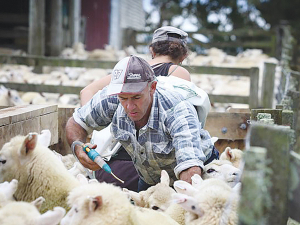Getting sheep shape at Pyramid Farm
The vineyards at Pyramid Farm in Marlborough’s Avon Valley have never been run of the mill, with plantings that follow the natural contours of the land, 250 metres above sea level.
 If the current trend continues, Techion predicts around 40% of NZ farms being impacted by combination drench failure in ten years.
If the current trend continues, Techion predicts around 40% of NZ farms being impacted by combination drench failure in ten years.
Undetected drench resistance is costing the NZ sheep sector almost $50 million a year — and it may only get worse.
Data collected from sheep farms across New Zealand over the past 15 years, by parasite diagnostic company Techion suggests that undetected drench resistance is costing the NZ sheep sector an estimated $48 million a year and that the problem is getting worse.
Drench resistance to triple combination drenches could rapidly increase to 40% if farm practices do not change.
This warning comes from analysis of 15 years of data – drawn from test results collected from 2005 to the end of July 2020 – that shows the speed of drench resistance is increasing.
Techion founder and chief executive Greg Mirams says his company has seen the incidence of drench resistance increase substantially. DrenchSmart is a faecal egg count reduction test (FECRT) that reports to farmers which drench actives are working effectively on their farms and which are not.
“In 2005 the resistance to combination drenches was low to non-existent. However, now it is becoming far more common, even to triple combination drenches,” Mirams explains.
He says that these results show double combination drenches are failing on between 20% and 43% of New Zealand farms, while triple combination drenches are currently failing on 15% of properties they have tested.
“We’re not trying to be alarmist. We’re simply drawing upon a significant body of data collected over a decade-and-a-half which proves, without a doubt, drench resistance in New Zealand is increasing rapidly,” Mirams adds.
“If farmers continue to use drenches the way they have for the past four decades, drench resistance will continue to develop. The problem is impacting animal welfare and performance, farm productivity and hurting New Zealand meat exports.”
Beef + Lamb NZ statistics show that New Zealand farmers sent 18 million lambs to slaughter in the 2019-2020 financial year. Studies have shown that undetected drench resistance can reduce carcase value by 14%.
Mirams believes this translates to undetected drench resistance costing NZ’s sheep sector in the region of $48 million per year in 2020. He says this means – at an individual farm level, for a property producing 4000 lambs per year – undetected drench resistance could cut income by $71,169 per year. “Undetected drench resistance is a significant issue as few farmers have tested drenches on their properties.”
If this trend continues, Techion predicts around 40% of NZ farms being impacted by combination drench failure in ten years, which would equate to a $128 million productivity loss a year.
According to a veterinary parasitologist Dr Matt Playford from Dawbuts – a diagnostic company in Australia – who presented on worm diagnostics at the New Zealand Society for Parasitology annual conference last year, a simple test can detect drench resistance and estimate exactly how bad it is.
“Once the test is completed, farmers can choose the appropriate drench and immediately see the benefits in growth rates, as well as in wool production and lactation. Choosing the right drench program also helps prevent pasture larval contamination and ensures that drenches last longer,” Mirams explains.
“It’s critical farmers test the efficacy of the drenches they use and utilise alternative measures to control parasites and protect the drenches which are still working effectively.”
He also cites international scientific research about slowing drench resistance in a paper published by Dr Ray Kaplan earlier this year, which recommends proven practices farmers can use to slow drench resistance.
Kaplan recommends farmers conduct drench resistance testing every 2-3 years so that they know which drenches work best. New animals should be quarantined and treated with the most effective drench available.
Farmers should also undertake a faecal egg count test (FEC) before and after drenching and only let animals join the farm if the FEC is negative after 14 days.
Mirams leaves the last word to a Central Otago farmer – a farming veteran of 20 years – who described the toll prolonged stock deaths due to drench takes.
“I urge people to get in and get a test if they have any doubt. Leaving it isn’t pretty.”
Mating wrapped up last month at the across-breed Beef Progeny Test on Pāmu’s Kepler Farm in Manapouri.
Libby Judson is a keeper of memories from an age gone by. Tim Fulton tells her story.
A New Zealand-first native tree study has highlighted the Bioeconomy Science Institute's position as a forestry research leader.
Hemp fibre processor Rubisco is relocating its core processing facility to Ashburton as part of a $20-$30 million expansion to leverage what it says is an accelerating global demand for sustainable and renewable fibres.
Tradition meets some of the latest in technology at the 2026 East Coast Farming Expo.
OPINION: Trade Minister Todd McClay and the trade negotiator in government have presented Kiwis with an amazing gift for 2026 - a long awaited and critical free trade deal with India.

OPINION: If the hand-wringing, cravat and bow-tie wearing commentariat of a left-leaning persuasion had any influence on global markets, we'd…
OPINION: With Winston Peters playing politics with the PM's Indian FTA, all eyes will be on Labour who have the…